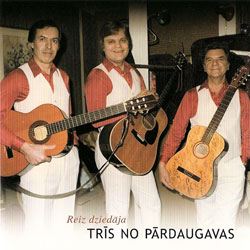
Liene Šomase is a young Latvian singer who is attempting to forge her own path. Also a saxophone player, she first became known in 2006 with her hit song “Ugunskurs.” Not long after that, she joined singer Jānis Moisejs to record the album Pasaule ir skaista, with music by Raimonds Pauls and lyrics by Guntars Račs.
The few songs that I have heard from that album seemed to be simple melodies, as can be expected from Pauls, but generally what one might call bubblegum pop music—sickly sweet flavor to start, but with a taste that quickly disappears. Šomase’s latest compact disc, 2008’s Vardos nepateiktais, takes a different road.
Besides being Šomase’s first solo album, the music on Vardos nepateiktais has more of a hard rock sound to it. Her MySpace page lists artists Faith Hill and Shania Twain as influences—women who have very successfully mixed a country music sound with a harder rock sound. According to the MySpace page, Šomase “sounds like” other female artists Natalie Imbruglia, Avril Lavigne, Pink and, very curiously, Madonna (that one I can’t see at all!).
Highlights of the album include the up-tempo opener, “Jauna diena,” as well as the song “Klauns (dzīve nav rožu lauks).”
The obligatory track in English, “Get Over It,” is a rather harsh break-up song, featuring lyrics like “If you get the urge to call me, you can call me history.” The poor guy must have messed up pretty bad to get this sort of treatment!
Šomase’s first hit, “Ugunskurs,” is also here. The song is certainly more in a šlāger vein than the other tracks, though certainly still catchy.
One needs only to look at the album liner notes to see that the cavalry has been called in to work on this album. Tracks have been penned by a number of heavyweight songwriters, including lyricist Račs, former Līvi guitarist Ainārs Virga, singer-songwriter Mārtiņš Freimanis of Tumsa, as well as singer Lauris Reiniks, former Double Faced Eels bassist Eduards Veinbrants and drummer Mārtiņš Miļevskis of group h2o, among many others. Performers on the album include Tomass Kleins (another former Līvi guitarist), keyboardist Zigfrīds Muktupāvels and guitarist Uģis Tirzītis (both of bet bet). The credits read like a who’s who of Latvian music.
With such a team behind it, one would expect the album to be quite good. And it is! Šomase’s voice works well with this type of music. The rock music gives her strong vocals a more natural and appropriate setting.
The CD comes with a largely forgettable DVD, with a few clips from her performances on the talent show “Dziedi ar zvaigzni.” They include rather ordinary talent show performances of songs like Randy Newman’s “You Can Leave Your Hat On” and Lou Bega’s “Mambo No. 5.” Of interest is the interpretation of the Līvi hard rock hit “Dzelzsgriezējs,” which switches from the hard rock original to a lounge interpretation.
Some may say that there isn’t much original on this CD, and, with the army of songwriters employed to make the record, it would be more of a surprise if the album wasn’t a hit. However, compared to a lot of the dreary and dull pop music that is currently being recorded in Latvia, this is significantly better. Certainly it will be interesting to find out if Šomase can develop her own songwriting talents (she has a partial credit on only one song, “Vai tu zini”). It might also be worthwhile to gather a set backing band. Many of the songs were recorded by completely different lineups.
All things considered, I quite enjoyed listening to this album. The songs are catchy and fun, and far more memorable than the ones on Pasaule ir skaista. The fact that many of the songs feature actual musicians (rather than computer programmers), with some songs even featuring real drums, is a big plus. Šomase has made a recording that stands apart from many of the other recent albums released by young singers and is well worth a listen!
Details
Vārdos nepateiktais
Liene Šomase
MICREC, 2008
MRCD 386
Track listing:
Jauna diena
Pilsēta dejo
Tik dīvaini tuvs
Svešādā dzīve
Klauns
Slēptākās domas
Bet vai tu zini?
Tu esi mana mīlestība
Get Over It
Ugunskurs
Where to buy
Purchase Vārdos nepateiktais from Amazon.com.
Purchase Vārdos nepateiktais from BalticShop.
Note: Latvians Online receives a commission on purchases.






